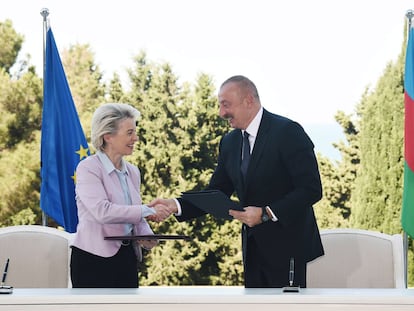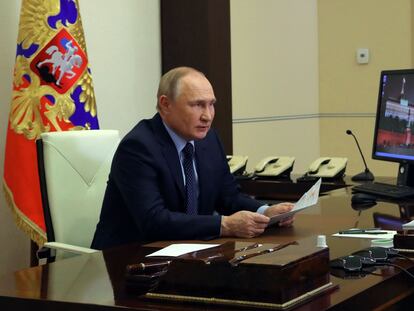Vladimir Putin arms his navy with hypersonic missiles as a warning to the West
The Russian president’s Navy Day speech in St. Petersburg outlines the nation’s new naval doctrine
Russian President Vladimir Putin put the West on notice in his July 31 Navy Day speech that delineated maritime interest zones in the Black, Baltic, and Arctic Seas as part of a new naval doctrine for Russia. He also announced that the Russian Navy will soon be armed with new, “unmatched” Zircon hypersonic cruise missiles that can travel up to nine times the speed of sound and have a virtually unlimited range. In 2018, Putin announced a program to develop these hypersonic weapons.
In his brief speech, Putin said, “We set the boundaries and areas of Russia’s national interests – economic, vital, and strategic – clearly and transparently. First and foremost, these are our waters of the Arctic, the Black Sea, the Sea of Okhotsk, the Bering Sea, and the Baltic and Kuril Straits. We will ensure their protection rigorously and using all available tools.”
Putin touted the capabilities of the Russian Navy as “… capable of instantly responding to all those who decide to impinge on our sovereignty and freedom, and successfully carrying out its strategic missions on the borders of our country,” and identified the Admiral Gorshkov frigate as the first to go on combat duty with this weapon aboard, which “… will be supplied to the Armed Forces of the Russian Federation within the next month.”
The new naval doctrine clearly reveals Moscow’s ambition to be a “great maritime power” and points to “the strategic policy of the USA to dominate the world’s oceans” and the movement of NATO closer to Russia’s borders as the main threats to its national security. It also establishes the Arctic Ocean as an area of particular importance. The US has accused the Kremlin of trying to militarize that area for years.
The 55-page document that was released sets out a policy of improving the country’s naval potential by streamlining resource mobilization under the Navy’s command, including civilian ships and crews, as well as the use of maritime infrastructure in wartime. Russia has nearly 25,000 miles (40,000 kilometers) of coastline.

Putin did not mention the war in Ukraine during his brief speech, but the new doctrine calls for “a comprehensive strengthening of Russia’s geopolitical position” in the Black Sea and the Sea of Azov. The Russian leader also connected past and present by praising St. Petersburg’s founder, Peter the Great, the czar who turned Russia into a major maritime power and propelled the country to global prominence. “Citizens of Russia, I congratulate you on Navy Day!” said Putin from the deck of a Russian launch in the Gulf of Finland, accompanied by Defense Minister Sergey Shoigu.
According to the Kremlin, the naval parade included more than 40 ships, submarines, and launches, 42 aircraft, and over 3,500 sailors. Similar celebrations were held in other ports, including the Baltic enclave of Kaliningrad between Poland and Lithuania. The celebration at St. Petersburg was followed by a signing ceremony for the new naval doctrine at the city’s historic Peter and Paul Fortress. The location was especially symbolic because Russia suffered its biggest setback of the war in Ukraine in April when the Moskva, the flagship of its Black Sea fleet, was destroyed. Ukraine never claimed responsibility for sinking the Moskva, but has hinted that they did it with help from the West. Since the invasion began in February, the Russian fleet has played an active role in missile attacks on Ukrainian territory.
Soon after Putin signed the new naval doctrine, Russia accused Ukraine of mounting a drone attack on the Sevastopol barracks of its Black Sea fleet in Crimea, the Ukrainian peninsula it illegally annexed in 2014. Sevastopol Governor Mikhail Razvozhaev posted to his Telegram channel that at least six people were injured in the attack, while Ukrainian officials in Kyiv immediately denied any involvement. A day earlier, pro-Russian authorities in Sevastopol announced that the traditional naval parade in the Crimean port would not be held for security reasons.
In the early hours of the morning, Russian artillery pounded the southern Ukrainian city of Mykolaiv, said regional governor Vitali Kim, describing it as “probably the most intense [attack]” since the war began five months ago. Two civilians were killed in the attack, identified as Oleksiy Vadaturski and his wife. Vadaturski was the founder and owner Nibulon, a major grain producer and exporter.
The 74-year-old grain tycoon had an estimated fortune of US$450 million in 2020, according to a BBC report that cited Forbes magazine. In 2021, Nibulon had its best export year ever, according to the company’s website. “His contribution to the agricultural and shipbuilding industries, and to the region’s overall development is incalculable,” said the governor in a Telegram post.
Ukrainian media reports indicate that a missile hit Vadaturki’s home during the night. Mikhail Podoliak, an advisor to President Zelensky, said he believed Russia had deliberately targeted the businessman, noting that Vadaturski was one of the largest grain producers in Ukraine and a “key person” in the Mikolaiv region.
Tu suscripción se está usando en otro dispositivo
¿Quieres añadir otro usuario a tu suscripción?
Si continúas leyendo en este dispositivo, no se podrá leer en el otro.
FlechaTu suscripción se está usando en otro dispositivo y solo puedes acceder a EL PAÍS desde un dispositivo a la vez.
Si quieres compartir tu cuenta, cambia tu suscripción a la modalidad Premium, así podrás añadir otro usuario. Cada uno accederá con su propia cuenta de email, lo que os permitirá personalizar vuestra experiencia en EL PAÍS.
¿Tienes una suscripción de empresa? Accede aquí para contratar más cuentas.
En el caso de no saber quién está usando tu cuenta, te recomendamos cambiar tu contraseña aquí.
Si decides continuar compartiendo tu cuenta, este mensaje se mostrará en tu dispositivo y en el de la otra persona que está usando tu cuenta de forma indefinida, afectando a tu experiencia de lectura. Puedes consultar aquí los términos y condiciones de la suscripción digital.
More information
Archived In
Últimas noticias
Most viewed
- Sinaloa Cartel war is taking its toll on Los Chapitos
- Oona Chaplin: ‘I told James Cameron that I was living in a treehouse and starting a permaculture project with a friend’
- Reinhard Genzel, Nobel laureate in physics: ‘One-minute videos will never give you the truth’
- Why the price of coffee has skyrocketed: from Brazilian plantations to specialty coffee houses
- Silver prices are going crazy: This is what’s fueling the rally










































